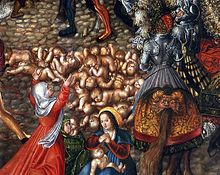Watoto wa Bethlehemu


Watoto wa Bethlehemu (waliuawa 5 KK hivi) ni watoto wa kiume wa chini ya miaka 2 waliopatikana Bethlehemu na kuuawa kwa agizo la mfalme Herode Mkuu (Math 2:16-18).
Sababu ni kwamba mamajusi kutoka mashariki walikuwa wamefika Yerusalemu ili kumtafuta mfalme wa Wayahudi aliyezaliwa na hatimaye kumzawadia. Habari hiyo ilimshtusha Herode na kumfanya atake kumuua.
Aliposikia kwamba mamajusi walirudi kwao kutoka Bethlehemu bila kumpa taarifa kamili juu ya mtoto, aliagiza wauawe watoto wote wa kiume wa kijiji hicho wenye umri chini ya miaka 2.[1]
Imekadiriwa kwamba watoto hao waliweza kuwa 20-40 hivi[2][3].
Hata hivyo, mlengwa mwenyewe, Yesu, alinusurika kwa wazee wake kutoroka naye hadi Misri, waliposhi kama wakimbizi mpaka baada ya kifo cha Herode.
Kwa kuwa watoto hao waliuawa kwa niaba ya Yesu, wanaheshimiwa na Wakristo wa madhehebu mengi kama wafiadini[4].
Sikukuu yao inaadhimishwa tangu karne ya 5, hasa tarehe 27 Desemba na 28 Desemba[5].
Ingawa habari hiyo haipatikani nje ya Injili, tabia ya Herode ilikuwa ya namna hiyo, hata aliua watoto wake 3, mke wake mmojawapo na mama-mkwe[6][7].
Tazama pia
[hariri | hariri chanzo]- Watakatifu wa Agano la Kale
- Orodha ya Watakatifu Wakristo
- Orodha ya Watakatifu wa Afrika
- Orodha ya Watakatifu Wafransisko
Tanbihi
[hariri | hariri chanzo]- ↑ Matthew 2:17: "Then was fulfilled that which was spoken through Jeremiah the prophet, saying, 'A voice is heard in Ramah, mourning and great weeping, Rachel weeping for her children and refusing to be comforted, because her children are no more.'"
- ↑ Raymond E. Brown
- ↑ Donald A. Hagner, World Biblical Commentary, Matthew 1-13, page 37
- ↑ Bill Doggett, Gordon W. Lathrop, New Proclamation Commentary on Feasts, Holy Days, and Other Celebrations, (Fortress Press, 2007) page 43.
- ↑ Martyrologium Romanum
- ↑ Josephus, Antiquities of the Jews, Book XV (at Wikisource)
- ↑ R. T. France, addressing the story's absence in Antiquities of the Jews, argues that "the murder of a few infants in a small village [is] not on a scale to match the more spectacular assassinations recorded by Josephus". R. T. France, "The Gospel of Matthew", NICNT (2007)
Marejeo
[hariri | hariri chanzo]- Albright, W. F. and C. S. Mann. "Matthew." The Anchor Bible Series. New York: Doubleday & Company, 1971.
- Clarke, Howard W. The Gospel of Matthew and its Readers: A Historical Introduction to the First Gospel. Bloomington: Indiana University Press, 2003.
- Robert Eisenman, 1997. James the Brother of Jesus: The Key to Unlocking the Secrets of Early Christianity and the Dead Sea Scrolls. Viking/Penguin.
- Goulder, M. D. Midrash and Lection in Matthew. London: SPCK, 1974.
- Jones, Alexander. The Gospel According to St. Matthew. London: Geoffrey Chapman, 1965.
- Schweizer, Eduard. The Good News According to Matthew. Atlanta: John Knox Press, 1975.
Viungo vya nje
[hariri | hariri chanzo]- Catholic Encyclopedia: "Holy Innocents"
- Images of the "Massacre of the Innocents"
- The Holy Martyred 14,000 Infants
- The Massacre of the Innocents by H. Colombo from the De Verda Collection
| Makala hii kuhusu mtu wa Biblia bado ni mbegu. Je, unajua kitu kuhusu Watoto wa Bethlehemu kama habari za maisha au kazi yake? Labda unaona habari katika Wikipedia ya Kiingereza au lugha nyingine zinazofaa kutafsiriwa? Basi unaweza kuisaidia Wikipedia kwa kuihariri na kuongeza habari. |

